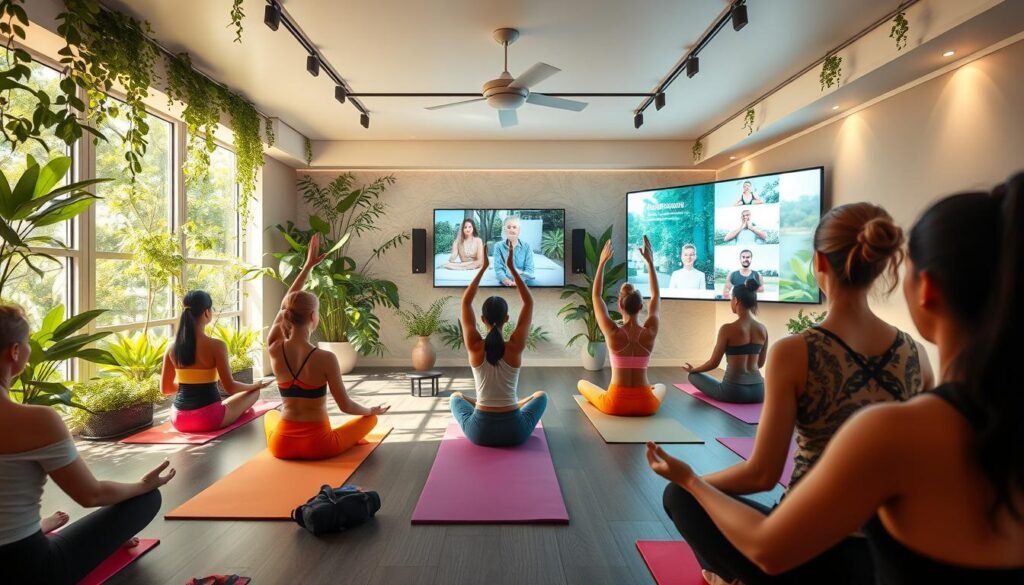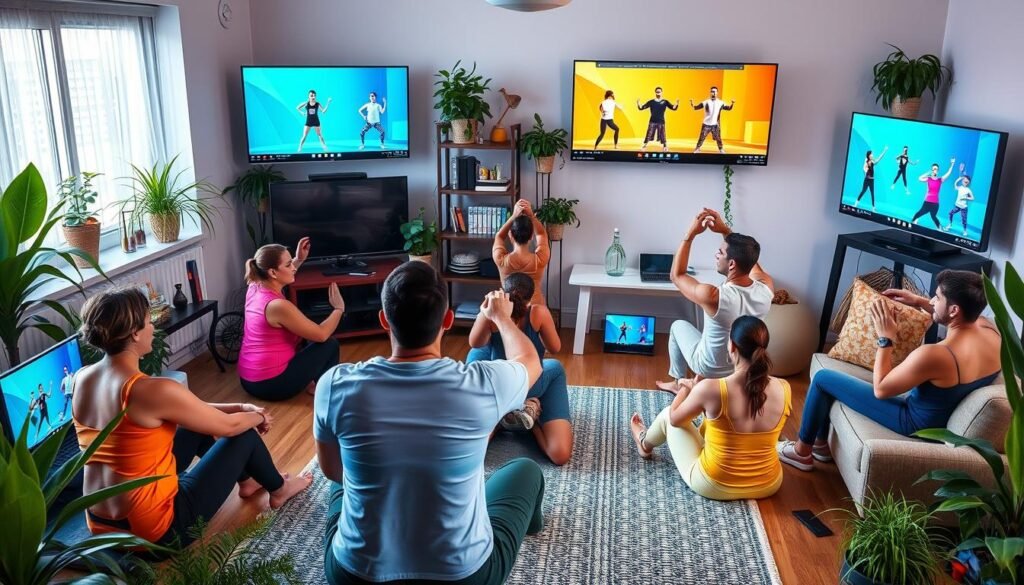These days, more people are trying virtual workouts. They are great for mental health. Exercise helps make you feel better, less stressed, and more confident. Working out at home is easy and you can do it any time.
Studies show that exercise is key for mental health. Running for 15 minutes or walking for an hour can lower depression risk by 26%, says Harvard T.H. Chan School of Public Health1. Activities like walking and swimming boost brain chemicals. These make you focus better, much like ADHD medicine1. Doing these exercises online is just as good as going somewhere to do them.
You can try many types of workouts at home, like yoga or intense ones. They help your mind stay strong and make you happier. If you’re curious about how these workouts help, check out this informational page.
Key Takeaways
- Virtual workouts are increasingly popular for mental health management.
- Physical activities like running can reduce the risk of depression by 26%1.
- Engaging in daily exercises online can improve mood, focus, and attention1.
- Virtual platforms offer diverse options like yoga, HIIT, and strength training.
- Exercise enhances neurotransmitter levels, impacting mental well-being positively1.
The Rise of Virtual Workouts
Virtual workouts have become more popular recently. This is because technology has advanced and there’s easier access to fitness online. The fitness world is big, making $94 billion in 2018. Even though the pandemic caused some ups and downs, digital workouts grew. They let people choose their workouts better than gyms2.
In 2020, a study by ClubIntel found something interesting. 54% of 2,000 people asked either stopped or dropped their gym memberships because of the pandemic. This shows how important online fitness has become2.
ClassPass links fitness clubs with remote classes. They work with over 30,000 club partners in the U.S. and 27 other countries. This shows that digital fitness classes are loved all over the world2.
The demand for fitness products for home use jumped 300% after the World Health Organization called COVID-19 a global pandemic3.
Online workout platforms are great because they are easy to use. They fit well into busy schedules and don’t cost too much. Adding technology like smartwatches and apps makes working out even better2. Virtual exercises, like live video classes, are here to stay. They work well and are easy to get to2.
Now, you can find short, effective workouts online. These can be as quick as 5 to 15 minutes4. Tools like Peloton and Supernatural have created friendly online spaces. Users see big health wins, like losing weight and feeling happier. This shows the good things virtual workouts can do2. During the pandemic, these benefits have been even more important.
The Connection Between Physical Activity and Mental Well-being
Working out helps improve mood and controls stress. You can exercise at home for mental health. There are also online exercises that help make staying active easy.
Impact on Mood and Stress Levels
Exercising releases endorphins. These make you feel less stressed, anxious, and sad5. People call this happy feeling the “runner’s high.” Also, being active makes your body better at handling stress5.
Even online exercises help your mood and brain feel better. They do this by activating the brain’s happy chemicals5.
Benefits for Self-Esteem and Confidence
Being active boosts self-esteem and confidence. It makes you feel good about yourself. And it helps you see what you can achieve, which is important for mental health.
For example, exercising every day fights off feelings of giving up. It encourages you to keep going. This boosts your self-esteem6. Also, staying active improves memory, attention, and solving problems. Better brain skills increase confidence. This makes facing life’s challenges easier.
To learn more about how exercise helps mental health, check out this review article5.
How Virtual Fitness Programs Support Mental Health
Virtual fitness programs make it easy to stay fit on your schedule. Apps like MyFitnessPal and Nike Training Club offer workouts made just for you. They help you reach your fitness goals7.

Convenience and Accessibility
Virtual fitness programs are super convenient. With Talkspace and BetterHelp, you can have therapy anywhere. These services help break down barriers to therapy7.
A study found group exercise improves mental health in just 10 weeks. It shows how important access to fitness is for our minds8. Integrative Psych makes finding mental wellness support online easier7.
Diverse Range of Activities
There’s a wide variety of virtual activities for everyone. Whether it’s gentle yoga or intense workouts, there’s something for all levels. More people are choosing mind-body classes like yoga to feel better9.
Exercising in groups or alone can boost your mental health. The SCOPE trial showed big improvements in how participants felt8.
Types of Virtual Workouts to Try
Finding the right virtual workout is key. You can pick from yoga, meditation, HIIT, or strength training and Pilates. These can greatly help your mind feel better.
Yoga and Meditation
Yoga online helps you feel less stressed and more at peace. Alo Moves gives you yoga, fitness, and meditation for $20 a month or $199 a year10. Yoga can make you mentally healthier, lower depression, and boost happiness11. Wellbeats also has yoga classes for calming and stress relief11.
High-Intensity Interval Training (HIIT)
HIIT online is tough but rewarding for both mind and body. It mixes high-speed exercises with short breaks. This can make you more energetic and focused. Aaptiv lets you try HIIT free for seven days, then it’s $99.99 a year or $14.99 a month10.
Doing HIIT at home can work as well as the gym for muscles, fat loss, and fitness12. Peloton gives free classes for 30 days, then it’s $12.99 a month. Bike or Tread subscribers get extra features10.
Strength Training and Pilates
For stronger muscles and endurance, try strength training and Pilates online. The be.come Project has a ten-day free trial, then it’s $35 a month. It suits all fitness levels10. Doing these workouts often lowers stress and gives you a sense of success11. Crunch Fitness offers many online workouts to make fitness easy for everyone10.

Overcoming Barriers to Physical Activity
Virtual workouts are a game changer for fitness. They help us get past common hurdles like not having enough time, motivation, or a gym close by. With these workouts, people can exercise when it suits them best. This makes it easy to include exercise in our daily life. Looking at our schedule to find three 30-minute slots each week for things like walking or working out while watching TV is a smart move. This helps make exercise a regular part of our day13.
Sometimes, not having support from friends or family can stop us from exercising. We can fix this by sharing our fitness goals and doing activities together. For example, walking our pets together or going for a walk after meals is fun14. Also, to beat the lack of motivation, we should keep our workout clothes ready to go. Joining a group or finding the best time when we feel most energetic for exercises can help too14.
Virtual fitness means we don’t need to travel to a gym. This solves the problem of not having certain resources. Using free workout videos online and doing simple activities that don’t need much gear, like jogging or exercises using our body weight, are good choices. These steps are key to making virtual fitness easy for everyone and overcoming these common problems14.
It’s also key to stay motivated by setting personal fitness goals and finding activities we love. Changing up our workout routine and trying new things can keep us interested. Getting support from our friends and using apps or calendars to keep track of our progress are great ways to stay on track. These strategies help us meet our fitness goals15.
Using places like local parks, work programs, and indoor options means we can keep exercising no matter the weather or our schedule. Making the most of these resources and finding them in our community is important. This helps make exercise a normal part of our life13. Mixing these tips with what virtual fitness offers can really improve our health. It gives us tools to beat exercise barriers and make healthy habits stick.
Overcoming barriers to physical activity helps us feel and think better. It lets us bring movement into our everyday lives. This brings out the best in physical activity.
Virtual Fitness for Mental Health: Real-Life Benefits
Many people have seen their mental health get better with virtual fitness. These positive changes are big. For example, using 30 minutes less social media and doing physical activity instead can make you feel better and less stressed benefits of online workouts16. A study showed that cutting down social media by 37 minutes and exercising for 26 minutes led to more happiness and less stress, even after six months16.
Virtual fitness stories also tell us about the benefits of walking, cycling, dancing, yoga, and Tai Chi. These activities increase feel-good chemicals in the body, improving how we feel17. They help lessen depression and anxiety, making us happier. Also, exercises in virtual reality helped people get fitter, stronger, and feel less tired, tense, or depressed, making life better17.
Online workouts are easy to do and suitable for many. During COVID-19, exercising more and using less social media made people happier and less stressed16. These online workouts fit different activities and preferences, helping everyone keep active and healthy.
Conclusion
Exploring the link between exercise and mental well-being shows virtual workouts help our minds. These online exercises are a big step in using fitness to stay mentally healthy. Studies show that exercise and mental health are closely linked, with 89 percent of studies finding good results18.
Virtual fitness is great because it’s easy to access. Doing these workouts regularly makes you feel better about yourself and less stressed. It can help fight sadness and worry by making happy chemicals in your brain19. Virtual races, like those on Distantrace.com, reduce depression and anxiety. They also make you feel better emotionally20.
Looking ahead, virtual fitness has a big future in helping our minds. Websites like HealthFitnessScience.com offer helpful tips for adding exercise to mental health care. Virtual fitness is changing how we look after our mental health for the better. Being part of a community that focuses on healthy living can lead to lasting positive changes.
Source Links
- The Mental Health Benefits of Exercise – HelpGuide.org – https://www.helpguide.org/wellness/fitness/the-mental-health-benefits-of-exercise
- Growth of Virtual Exercise: The Fitness Industry After Coronavirus – https://online.maryville.edu/blog/virtual-exercise/
- Virtual Fitness: investigating team commitment and post-pandemic virtual workout perceptions – https://pmc.ncbi.nlm.nih.gov/articles/PMC9135496/
- 4 Benefits of Virtual Workouts and Why They’re Here to Stay – Fitbit Blog – https://store.google.com/intl/en/ideas/articles/benefits-virtual-workouts/
- Connection between Physical health and mental health – https://excel-psychiatry.com/connection-between-physical-health-and-mental-health/
- The relationship between physical inactivity and mental wellbeing: Findings from a gamification-based community-wide physical activity intervention – https://pmc.ncbi.nlm.nih.gov/articles/PMC5774736/
- Enhancing Well-Being: The Intersection of Mental Wellness, Physical Fitness, and Teletherapy Apps, NYC – https://integrative-psych.org/resources/enhancing-well-being-the-intersection-of-mental-wellness-physical-fitness-and-teletherapy-apps
- Online-Delivered Group and Personal Exercise Programs to Support Low Active Older Adults’ Mental Health During the COVID-19 Pandemic: Randomized Controlled Trial – PubMed – https://pubmed.ncbi.nlm.nih.gov/34328433/
- Lifestyle Fitness Activity courses help students improve physical and mental health – https://education.wayne.edu/news/lifestyle-fitness-activity-courses-help-students-improve-physical-and-mental-health-42691
- Virtual Workouts Bring Fitness Wherever You Are – https://www.betterup.com/blog/virtual-workout
- Fitness for Mental Health – https://www.wellbeats.com/fitness-for-mental-health/
- 23 best home workouts + 9 virtual fitness platforms to try now – https://www.womenshealthmag.com/uk/fitness/workouts/a707729/home-workouts/
- Overcoming Barriers to Physical Activity – https://www.cdc.gov/physical-activity-basics/overcoming-barriers/index.html
- Breaking Down Barriers to Fitness – https://www.heart.org/en/healthy-living/fitness/getting-active/breaking-down-barriers-to-fitness
- Overcoming Exercise Barriers | Howdy Health – https://howdyhealth.tamu.edu/overcoming-exercise-barriers/
- Mental health benefits of replacing social media with exercise – https://www.medicalnewstoday.com/articles/swapping-30-minutes-of-social-media-use-per-day-with-exercise-benefits-mental-health
- Real-Life Benefits of Exercise and Physical Activity – https://www.nia.nih.gov/health/exercise-and-physical-activity/real-life-benefits-exercise-and-physical-activity
- Mental Health Benefits of Exercise | Freemotion Fitness – https://freemotionfitness.com/featured-content-posts/mental-health-benefits-of-exercise/
- Boosting Your Mental Health: The Transformative Power of Fitness – https://www.portagepath.org/mental-health-and-fitness/
- Unlocking Mental Wellness: How Virtual Races Enhance Psychological Health – https://distantrace.com/en/blog/unlocking-mental-wellness-how-virtual-ra/
